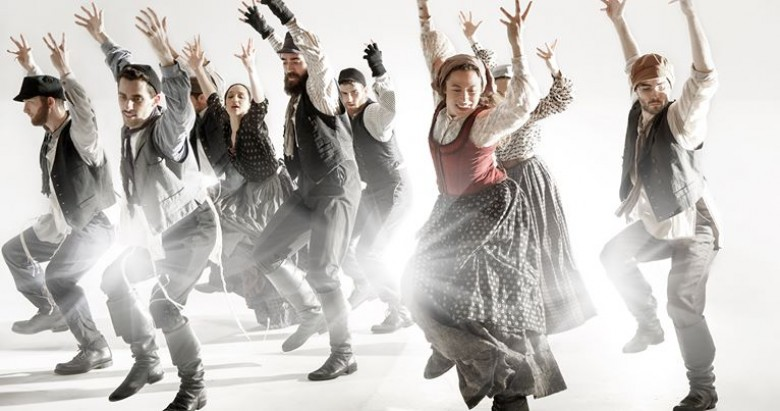Fiddler on the Roof, at Shea’s Performing Arts Center until November 4th, is an homage to a peasant Jewish culture in Imperial Russia that was rich in tradition, yet also in the throes of internal change, that was forcibly scattered to the four winds over a century ago. With the current wave of anti-Semitism by white supremacists on the streets in Charlottesville and the synagogue in Pittsburgh, this is a timely and important revival of the beloved classic. Many are the religious, indigenous, and racial groups who have been the victims of pogroms, displacement, and holocausts over the millennia, and through its depiction of the lives of people in this Jewish shtetl, Fiddler on the Roof has been paying tribute to them since 1964 with warmth, humor, and respect—and a charismatic lead character and terrific choreography.
Based on stories by Sholom Aleichem, the show begins with Tevye dressed in contemporary clothes reading out loud. As he talks about the importance of tradition, the cast comes onto the empty stage and begins the rousing “Tradition,” the anthem that speaks to a desire for order and surety amidst chaos and the great unknown.
.
The story is about the couple Tevye and Golde who have five daughters and no sons. The daughters must be married, but the family is poor so there will be no dowries. Yente, matchmaker and gossipmonger, tries to find husbands for the girls, all needing the approval of the Papa. However, the girls have their own choices in mind, and the Papa is faced with a generational divide that angers and perplexes him, threatening his position as king of his thatched roof castle.
As the dairyman Tevye goes, so goes Fiddler, and both go extremely well in this production. Israeli actor Yehezkel Lazarov as Tevye is a marvel. His performance is nuanced, witty, subtle, vigorous, and full of warmth. His talks with God are less schtick and more conversation than in some past productions, giving his character more depth and a more contemporary feel. His is not a brittle patriarchal ego shattered by the willfulness of his daughters, but the gradual understanding of a loving patriarchal father for the welfare and happiness of his children. His dancing in “If I Were a Rich Man” is an expression of his strength, warmth, and humor and is a joy to behold.
All the choreography, recreated by Christopher Evans, is also a joy to behold. In “To Life,” which takes place in the tavern where Christians and Jews congregate, the combination of Russian and Jewish dancing is spectacular, with the two traditions melding together in an energetic, almost frantic exhibition of what could be possible were the two cultures to mingle in life as well as in dance, each maintaining their own traditions, interacting with grace and verve to produce a beautiful ballet. The bottle dance as performed at the wedding of Tzeitel and Motel is not a traditional Jewish dance but is a show-stopper from the mind of original director and choreographer Jerome Robbins. I thought the men might have cheated and used Velcro to keep those bottles on their heads while they moved from standing to kneeling to dancing on their knees in unison, but they did not. Fascinating.
There is more, much more in the choreography in this show that dazzles the eye. For instance, the dancing ghosts in “Tevye’s Dream” have large, comically gruesome heads, with some creatures on stilts and one giant being with foot-long fingers as they all do a macabre dance around the twin beds of the couple.
Maite Uzal as Golde has a sharp tongue without being shrewish, and holds her own with the demanding Tevye, often outwitting him. In their charming duet, “Do You Love Me?”, Ms. Uzal sweetly admits to her love without expressing a shred of sentiment, a feeling she neither values nor can afford. Carol Beaugard as Yente seems rather flat in her delivery, so the humor in her gossiping is not as funny as it might be in a livelier performance. The remainder of the large cast are very much up to the mark. Each of the three marrying-age daughters has her own personality and desires that she courageously expresses to Papa, as do the young men they love.
The sets by Michael Yeargan evoke the primitiveness of the shtetl in the rural farm of Tevye, with its thatched roof and wood-burning stove. The tavern has a back wall, a bar, and a few tables and chairs, and the bedroom of Tevye and Golde is simply two twin beds with an empty frame between them on the non-existent wall behind them. The sets are simple and speak to the times.
The classic songs and music are given their due. My companion said she had to hold herself back from singing along with “Matchmaker, Matchmaker,” “If I Were a Rich Man,” and “Sunrise, Sunset.” I appreciate her discipline and that of what I am sure are many others in the audience with the same urge, possibly myself included. Luckily, we stifled ourselves and left it to the experts on stage and in the pit, who rewarded us with a beautiful evening of song and dance.
This production of Fiddler on the Roof is traditional and contemporary, and not merely a blast from the past. It has a great deal to say about changing generations in families as well as broader cultural ramifications. It is a pleasure to see.

